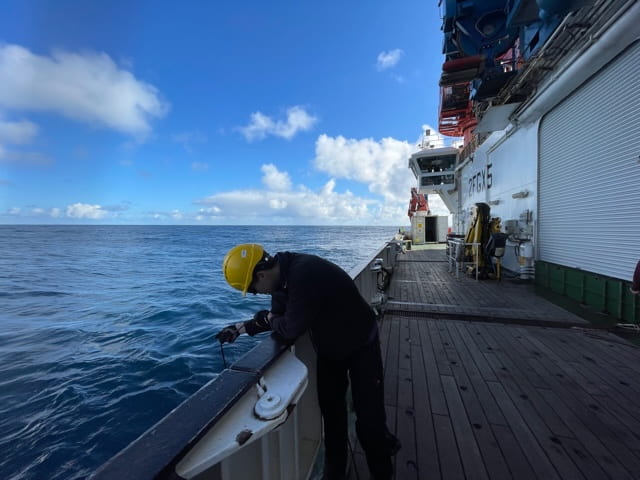Globally significant upwelling is driven by topographical features on seafloor

Henri Drake, UC Irvine assistant professor of Earth system science, shown here aboard the U.K. research vessel RRS Discovery, used an acoustic transducer to locate moorings that he and his fellow scientists had anchored on the seafloor about a mile below the surface. The team worked to develop a better understanding of the way seawater upwells from dense, cold layers at the ocean’s bottom to upper strata.
Irvine, Calif., July 9, 2024 – Exactly how the turbulent mixing of ocean water relates to global overturning circulation has been little understood by oceanographers, but an international research team, including an Earth system scientist at the University of California, Irvine, has found that bumpy topographical features along the sloping ocean floor contribute significantly to ocean seawater upwelling.
In a paper published recently in Nature, the researchers describe a “vigorous near-bottom upwelling” that results in the upward transition of water from denser to lighter ocean layers at a rate of 100 meters (328 feet) per day. They discovered this by depositing and analyzing dye at a sloping suboceanic canyon in the North Atlantic Ocean off the coast of Scotland.
“The upwelling rates we tracked at this underwater canyon were about 10,000 times higher than the global average,” said co-author Henri Drake, UC Irvine assistant professor of Earth system science. “These findings suggest that most of the upwelling required to balance the deep ocean’s mass budget disproportionately occurs in a few turbulent hot spots like this one.”
By getting colder and saltier, dense water forms in polar regions and sinks to the ocean’s abyss, where pressure increases and the temperature drops. This process is crucial to global climate regulation through its transfer of heat and nutrients throughout the ocean. The means by which this dense water returns to the surface – a phenomenon known as diapycnal upwelling – have puzzled scientists and hampered the accuracy of climate models.
Aboard a research vessel, the scientists added dye at a depth of about 1,850 meters (6,070 feet) within the underwater canyon and then measured the results over several days by towing sensors that ascended and descended in a yo-yo pattern.
“We found that, on average, the dyed water became lighter at a rate of about a quarter of a degree Celsius per day,” Drake said. “Because warmer water is generally lighter than cold water, and because light water tends to lie atop denser water, we estimate that this corresponds to a 100-meter-per-day upwelling rate.”
He said the study provides direct evidence confirming earlier theoretical predictions about ocean circulation and mass balance. In addition, he said, the research contributes valuable insights for climate scientists hoping to understand the mechanisms governing our planet’s oceans and will help them derive more precise projections of marine impacts on global climate change.
Joining Drake in this project were scientists from UC San Diego’s Scripps Institution of Oceanography; the Massachusetts Institute of Technology; Ifremer, the French national institute for ocean science and technology; the University of Exeter, in the United Kingdom; Boston University; the U.K.’s National Oceanography Centre; the Royal Netherlands Institute for Sea Research; and Woods Hole Oceanographic Institution, in Massachusetts. The study received financial support from the National Science Foundation and the U.K.’s Natural Environment Research Council.
About UC Irvine’s Brilliant Future campaign: Publicly launched on Oct. 4, 2019, the Brilliant Future campaign aims to raise awareness and support for UC Irvine. By engaging 75,000 alumni and garnering $2 billion in philanthropic investment, UC Irvine seeks to reach new heights of excellence in student success, health and wellness, research and more. The School of Physical Sciences plays a vital role in the success of the campaign. Learn more by visiting https://brilliantfuture.uci.edu/uci-school-of-physical-sciences.
About the University of California, Irvine: Founded in 1965, UC Irvine is a member of the prestigious Association of American Universities and is ranked among the nation’s top 10 public universities by U.S. News & World Report. The campus has produced five Nobel laureates and is known for its academic achievement, premier research, innovation and anteater mascot. Led by Chancellor Howard Gillman, UC Irvine has more than 36,000 students and offers 224 degree programs. It’s located in one of the world’s safest and most economically vibrant communities and is Orange County’s second-largest employer, contributing $7 billion annually to the local economy and $8 billion statewide. For more on UC Irvine, visit www.uci.edu.
Media access: Radio programs/stations may, for a fee, use an on-campus studio with a Comrex IP audio codec to interview UC Irvine faculty and experts, subject to availability and university approval. For more UC Irvine news, visit news.uci.edu. Additional resources for journalists may be found at https://news.uci.edu/media-resources.
